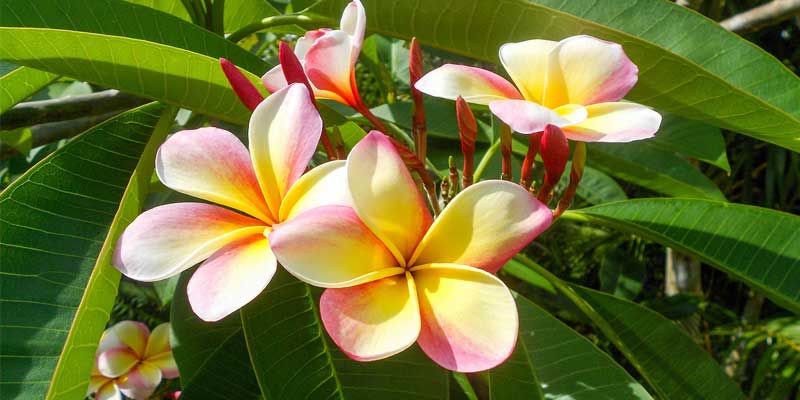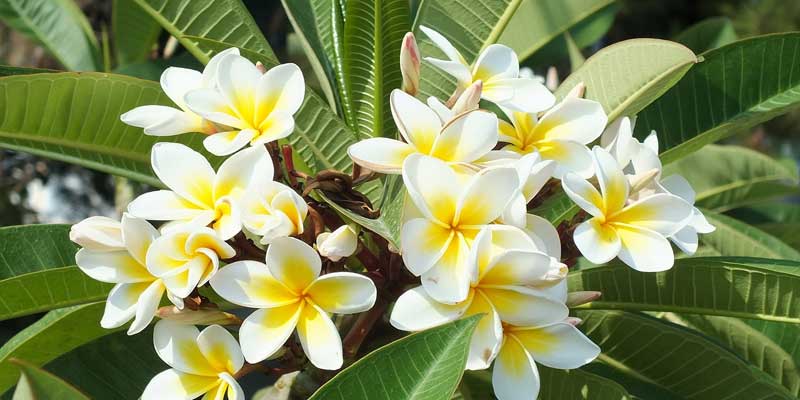With its vibrant and aromatic flowers, Plumeria – a tropical plant – captivates the hearts of gardeners and enthusiasts worldwide; indeed, adequate sunlight is indispensable for its abundant thriving and blooming. To ensure their healthiness and growth, understanding the optimal sun requirements for Plumeria plants becomes not just important but imperative.
This article delves into the nuanced sunlight requirements for plumeria to flourish; it explores with depth and precision the quantum of sun exposure necessary for optimal growth.
Understanding Plumeria Plants
The genus Plumeria, known colloquially as frangipani, originates from tropical and subtropical regions. Renowned for their fragrant and colorful flowers that grace gardens, landscapes – even indoor spaces in temperate climates – these plants offer a striking contribution to botanic aesthetics.
Notably reliant on sunlight exposure; it is this factor that largely determines the thriving capacity of a plumeria.
Sunlight Requirements for Plumeria
Full sunlight fuels the thriving of Plumeria plants. To foster healthy growth and abundant flowering, they demand a minimum of six to eight hours of direct exposure daily to sunlight. In tropical regions where Plumerias naturally inhabit, ample sunlight is a key element in their cultivation outside native environments; thus it remains crucial for reproducing these conditions effectively.
Optimal Sun Exposure
Place Plumeria plants in areas that consistently receive sunlight throughout the day; ideal locations are those facing south or west. The intense daylight these regions capture especially during midday hours. Ensures sufficient light for photosynthesis and promotes flower production, which is a key factor to consider when positioning your plumerias.
Morning Sun vs. Afternoon Sun
Full sunlight is a requirement for plumeria; however, we must consider the subtle differences between morning and afternoon sun exposure. The morning sunlight often gentler and less intense than its afternoon counterpart proves ideal for certain plant species that may exhibit sensitivity to harsher conditions later in the day.
Morning sun exposure particularly benefits plumeria as it aids in leaf-dew evaporation and overall moisture reduction – factors crucial for mitigating fungal disease risks.
The afternoon sun, too, proves critical to the growth of plumeria. The intensity of this sunlight bolsters photosynthesis – a process vital for overall health and vigor in plants; hence an optimal balance between morning and afternoon exposure is necessary for thriving plumerias.
Protection from Harsh Sun
Plumeria thrives in full sunlight, yet it requires precautions against the intense and scorching rays – particularly during peak daylight hours. In regions where temperatures soar to extreme levels; a provision of shade during these hottest parts can serve as a preventive measure against both sunburn and heat stress for your plumeria plants.
Sun Requirements for Potted Plumeria
The sunlight requirements for plumeria grown in containers or pots persist unchanged; however, potted plumeria may demand more frequent watering, and they tend to desiccate faster than those rooted in the ground. To foster thriving under direct sunlight–a critical factor–adequate drainage and optimal soil moisture levels are imperative.
Optimum drainage and appropriate soil moisture levels are crucial for potted plumeria’s thriving under direct sunlight; therefore, ensure these conditions, more specifically, provide regular watering due to their propensity to dry out faster than ground-planted counterparts.
Adjusting Sun Exposure in Different Climates
Plumeria’s sunlight requirements may exhibit slight variations according to climate and geography. Yet, in cooler or shorter daylight regions, plumeria can thrive even with a slight decrease in exposure to sunlight as long as they receive a minimum of six hours directly daily.
In tropical regions where intense sunlight persists throughout the year, a proactive measure such as shading or filtering sunlight during peak heat can protect plumeria plants from potential sunburn and leaf damage.
Signs of Sun Damage
It’s essential to monitor plumeria plants for signs of sun damage, which can include:
- Yellowing or browning of leaves
- Leaf wilting or drooping
- Sunburn spots or patches on leaves and stems
Observing any signs of sun damage necessitates action by adjusting the plant’s exposure to sunlight or offering temporary shade. This intervention not only prevents further harm but also fosters recovery, a crucial step in maintaining optimal health for your vegetation.
Overwintering Plumeria
Plumeria plants may enter a dormant phase in the winter months, necessitating decreased sunlight and water. People who reside in regions with cold winters should move their plumerias indoors or position them at a sheltered location to shield this delicate flora from frost and freezing temperatures.
Even when kept indoors, providing bright but indirect sunlight for plumeria is crucial; it sustains their health by averting overstretching or stem etiolation.
Conclusion
To conclude, an essential aspect of plumeria plant growth, flowering, and overall health is understanding their sunlight requirements. For optimal thriving and the production of stunning blooms, provide ample sunlight, preferably six to eight hours of direct exposure daily. Year-round enjoyment of Plumeria’s beauty can be achieved by gardeners through vigilant sun-exposure monitoring; protection from intense sunlight, which is a necessary adjustment based on climate and environmental factors is also crucial.



Leave a Reply